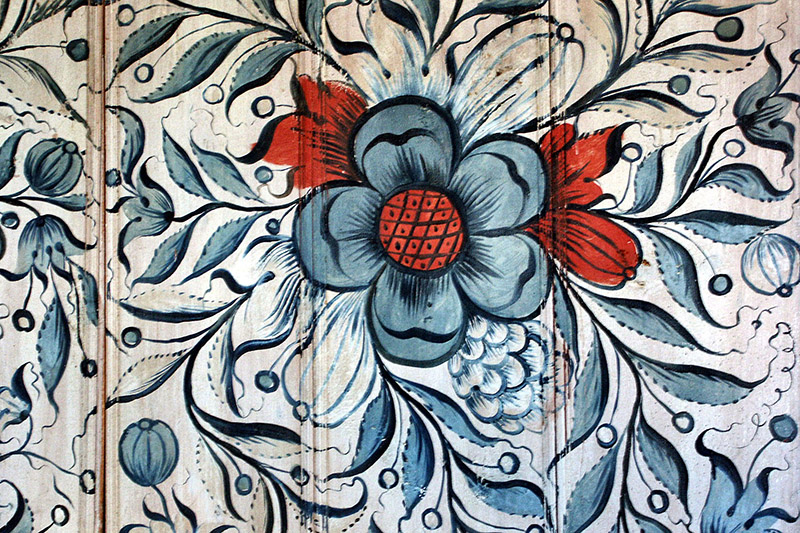A Brief History of Rosemaling

Decorative painting was practiced in Europe for centuries, but the style called Rosemaling is a unique Norwegian expression of it. It is also a relatively young artistic genre not taking off till the mid 1700’s. The reason for this has to do with the living conditions for the vast majority of Norwegians.
All through the Middle Ages and well into the 1700’s and beyond, the typical Norwegian farmhouse was a single-story log building with no windows. The main room, which was usually the only room, had a stone or earth floor with an open and slightly elevated fireplace in the middle and a smoke vent in the roof. As a result, the upper part of the room was usually black from soot and the only outside light came through the main entrance door or from the smoke vent. Color was introduced only on special occasions when tapestries were hung on the walls.
But in the 1700’s Norway’s economy began to improve and technical advances were introduced such as closed fireplaces and chimneys that allowed smoke to escape. New houses also had windows. After centuries of living in small, dark, smoke filled rooms, people finally had houses that let in light and fresh air.
The first wave of rose painting started in the south-eastern parts of the country. Here Norwegian artists trained in guilds and took their inspiration from the Baroque and Rococco styles used in Europe and popular with the Norwegian upper classes. They then travelled from county to county, painting the homes and furnishings of well-to do farmers for a commission of either money or room and board. But as these artists travelled farther away from the influence of the guilds, the creative urge took hold and they began to try out new motifs. Before long, many artists developed their own unique styles.
In addition, numerous rural amateur artists took up the paintbrush. They would not afford to hire a painter, but wanted this world of color along with the status of painted objects, in their homes. Having no formal training, they painted their own interpretations of what they had seen and in the process developed their own original patterns and designs.
In this way rosemaling moved across the country carrying with it a joyful world of color and flowing floral patterns, and in each region unique styles arose. Although rosemaling means rose painting, there are no obvious roses in any of the distinctive styles found throughout Norway. The designs are too stylized for any specific flower to be identified. And the term itself may have nothing to do with roses. Instead it probably originates from Norwegian dialects where words like rosut, rosete or rosa mean decorative or decorated.

For about 100 years rosemaling was all the rage. Everything made of wood was painted: the walls, ceilings, beds and built in cupboards. Freestanding objects were especially popular to paint such as ale bowls, trunks, dressers, clocks, saddles, harness parts, and sleighs, to mention just a few. But then, in the 1800’s rosemaling began to go out of fashion. But about the same time, especially throughout the second half of the 1800s, there was a vast wave of emigration from Norway to the new world of North America. The emigrants brought along some of their most treasured decorated objects such as trunks and bowls. Many of the skilled rosemalers also left the old country and travelled across the ocean. With them, they brought the art of rosemaling – and many continued their work in the new world. In this way rosemaling travelled with the immigrants to America. Here, in part thanks to Vesterheim Museum, it has continued to thrive.
Rosemaling is so exciting precisely because it took on such a unique expression in every region of Norway. It was not a fixed artform, but an inspiration for countless gifted painters who took what they saw and made it their own. For the art form to survive it needs to continue to evolve. To paraphrase Nils Ellingsen, one of Norway’s leading experts on rosemaling, if rosemaling is to have a future, it must not be standardized and massproduced. Instead, free imagination and unique expression must be encouraged. And that is just what Tara Austen’s exhibit Scandi Bijou is all about – taking an old tradition and putting her own creative spin on it, just like the travelling painters and the gifted amateur painters of old.
For a longer introduction to rosemaling, Vesterheim Museum has a wonderful link. https://vesterheim.org/what-is-rosemaling/

Photos from Wikimedia Commons.

